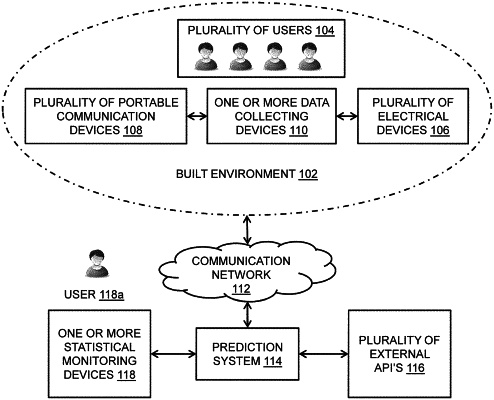| CPC G05F 1/66 (2013.01) [G06F 16/90324 (2019.01); G06N 7/01 (2023.01); G05B 2219/42001 (2013.01)] | 20 Claims |

|
1. A method for predicting a potential future energy consumption of a plurality of energy loads in a built environment, the method comprising:
collecting, at one or more collecting devices via a plurality of sensors, a first set of statistical data including a location, current energy consumption data, and past energy consumption data of a plurality of energy consuming devices present in the built environment based on a plurality of factors including current, voltage, power, thermal loss, device size, power rating, and duration of use for each of the plurality of electrical devices;
accumulating, at the one or more collecting devices, a second set of statistical data including a measure of usage patterns of the plurality of energy consuming devices and a physical location of a plurality of users present inside the built environment and operating the plurality of energy consuming devices;
analyzing the first set of statistical data and the second set of statistical data, by a prediction system having one or more processors and communicatively coupled to the one or more sensors, to determine a maximum consumption potential value of the built environment and generate a plurality of statistical results of energy consumption as a function of duration of operations and temperature, wherein the analyzing includes, by the one or more processors,
aggregating the current energy consumption data of the first set of statistical data for the plurality of energy consuming devices into pre-defined bins of time to generate aggregated current energy consumption data,
imputing one or more missing data points in the aggregated current energy consumption data by utilizing local polynomial interpolation, and
estimating a residual standard deviation of the aggregated current energy consumption data for each pre-defined bin of time; and
displaying, by the prediction system, a visible output to a user indicating the future energy consumption of each of the plurality of energy consuming devices.
|